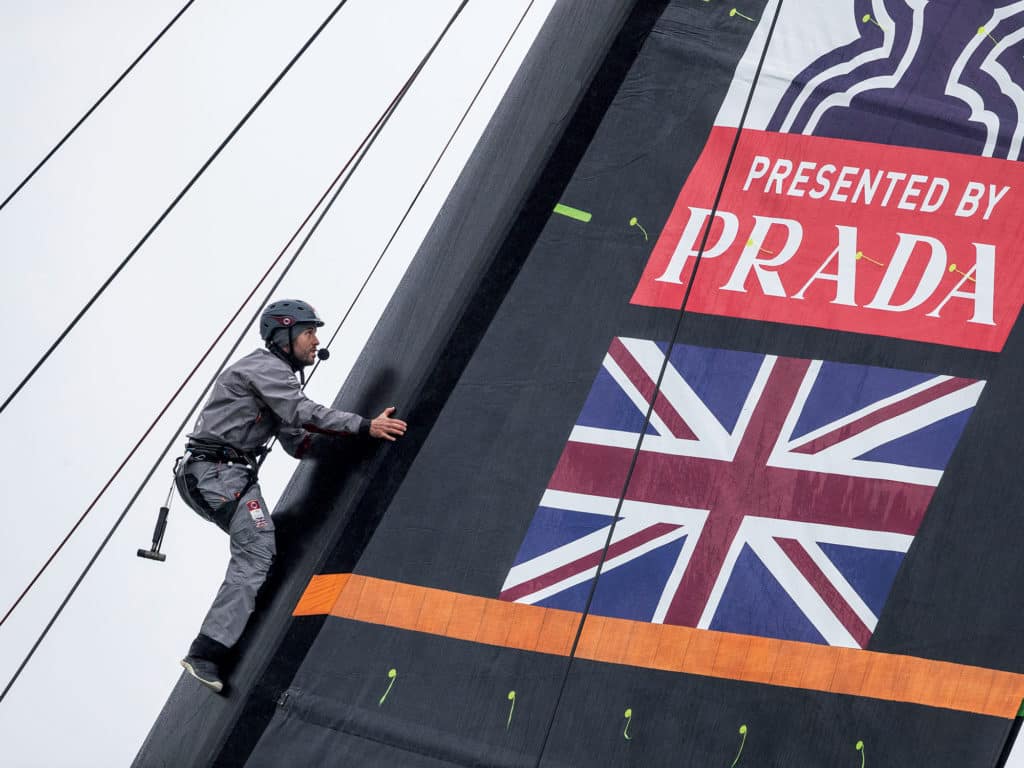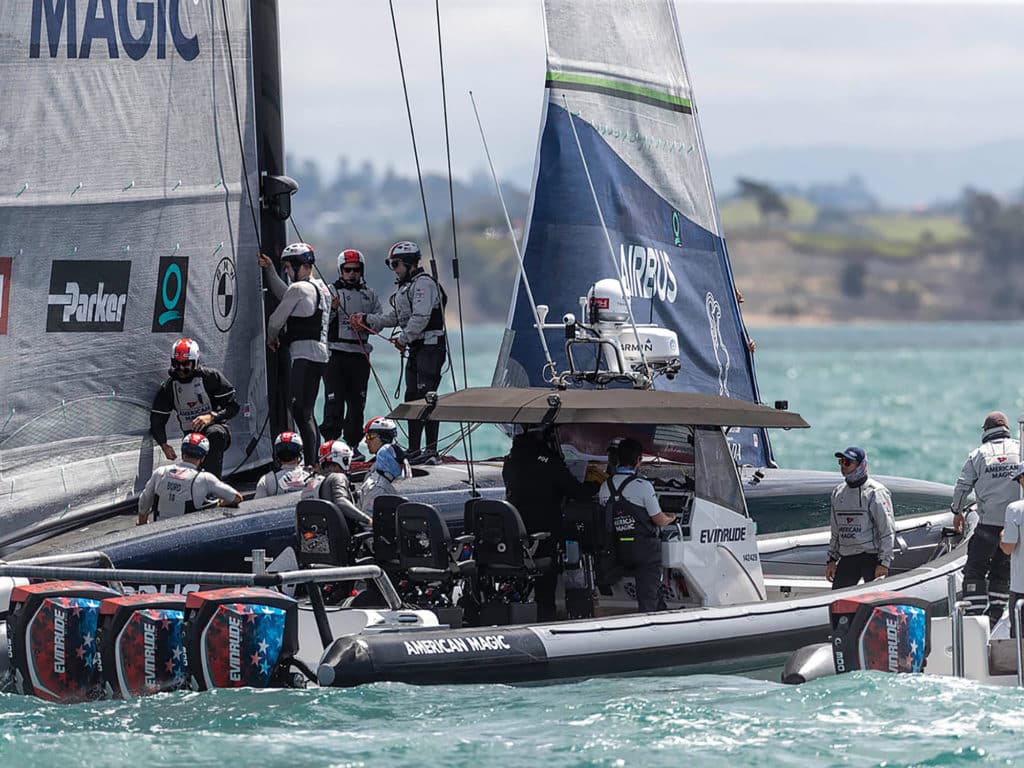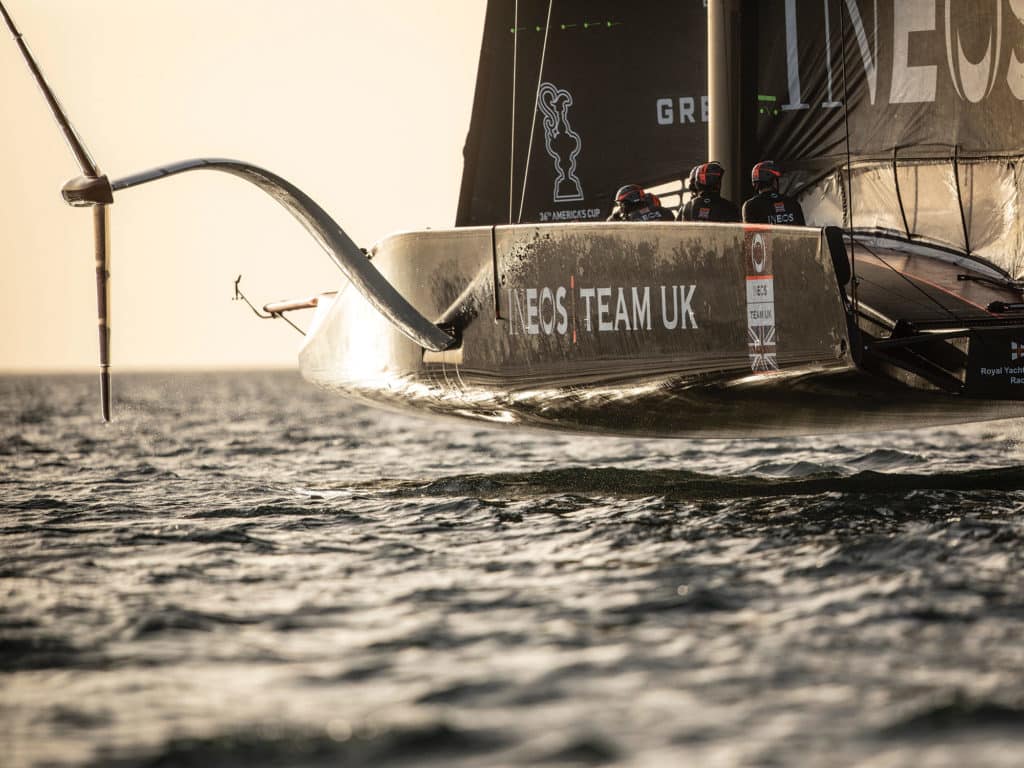Whether you’re for or against the new America’s Cup-class yachts, we can all agree that the massive lifting foils and wings have everyone’s attention. But another thing we can agree upon is that the AC75 is still a sailboat powered by the wind. If the sails aren’t fast, then a team will need to find a substantial advantage somewhere else to have any chance of hoisting the Cup aloft next March. So, in the spirit of the belief that “everything changes and everything stays the same,” the new technology we should be talking about this time around is the sails, what the inside techies refer to as the “aero package.”

The core of the AC75′s sail plan is the rotating soft-wing sail, comprised of two sails—or “skins”—of a double-sided mainsail that must be attached to each of the two aft edges of a D-section spar. The AC75 class rules that control all the components of the sail plan have the same mixed approach as the rest of the boat. There are supplied one-design parts, and then there’s wide latitude for innovation.
“The idea of the class rules is to have all the teams sailing with a similar mast but to let them be free to work on sails and control systems,” says Luna Rossa Prada Pirelli’s mainsail trimmer, Pietro Sibello. “The spar is dictated by a minimum scantling rule. Starting from the same laminate provided by the rule, we are allowed to reinforce it within known tolerances. By doing so, every team is responsible for the structure of their own mast.”
Standing rigging is supplied equipment as well and is the same for everybody, with that portion constituting a single set of spreaders and running backstays. Beyond supplied elements of spar and rigging, development is rampant and closely guarded—especially the shape-forcing components hidden between the skins. “For the sails, there are tolerances to make sure the boats on the starting line look like they are competing in the same class,” Sibello says, “but there is room to play with area, structure, geometry, shape and batten layout. And this is where the control systems are more open—in the lower zone and the upper zone we are allowed to have active control systems.”
This is where it gets interesting. There are no limitations in these two zones—identified by the class rule as the top 4 meters and the bottom 1.5 meters of the sail plan—where the only boundaries are set by the laws of physics and the cost.
The playing field is not short of either challenges or opportunities, but the first problem was to figure out what was the real nature of the problem. “This concept has been around for a really long time,” says Andrew Gaynor, a five-time Cup veteran, and now part of American Magic’s spar design team.
“I believe a patent was actually filed by L. Francis Herreshoff in 1920-something describing a twin-skin setup, [but] somewhere along the line, this idea always disappeared. Like, you don’t see this thing every day now. So at some point, all of these concepts have failed. Was this because of a material-science thing or is there some other fundamental flaw?
“So that’s an easy place to start trying to understand this thing. And then you’re like, well, what’s the goal? Is this thing a more refined, soft sail that everyone’s familiar with? Or is it another way of achieving the rigid wing that we’ve seen in the past couple of Cup cycles?”

Is it a rabbit or is it a hare? Time was the one thing that everyone needed to figure it out, particularly time on the water. Unfortunately, even before COVID-19 turned everyone’s world upside down, there was never going to be enough of it. The good news was that the onward march of technology had enabled an alternative: computer simulation.
“The struggle is to identify and properly model the physics of these twin skins,” Gaynor says. “There’s the way the two sails interact with each other and the way the air interacts around them. It’s not a rigid wing like we’ve been used to, and in the same respect, it’s not a single sail for which many mainsail design tools have been built over many years now. So it’s about developing a whole new set of tools to properly analyze this new setup. What we’re seeing more and more in this Cup is that modeling is king. If you can nail your model and nail it early, then it’s a huge advantage because of the time it requires to build and test something in real life,” Gaynor adds.
North Sails is building sails for Emirates Team New Zealand, Luna Rossa Prada Pirelli and INEOS Team UK. JB Braun, North’s director of design and engineering, has been the man in the hottest seat. “We didn’t really have any good tools for double-surface sails at that time,” Braun says. “Our North Design Suite wasn’t oriented to develop or analyze a double-surface main. So when the rule was being created, we committed our resources to developing our fluid structure interaction codes to allow us to analyze these sails, creating the powerful suite of tools we enjoy today. We incorporated the ability to add the two control arms, and have a D-section mast and two sails coming off that,” as specified in the AC75 rule.
The design tools are intended to simulate a sail’s performance by calculating how the initial shape changes under pressure applied by the wind, creating the flying shape. This process uses Fluid Structure Interaction software, and it pretty much does what it says on the tin: calculating how the sail structure is modified by its interaction with the fluid. Once the flying shape is calculated by the FSI code, the next stage is to use computational fluid dynamics programs to calculate the amount of force generated by the sail plan. Sometimes it’s easier to visualize this force by describing it as a point (the center of effort) through which the force acts.

“That [force vector] is generated from changes in sail shape, and using the fluid structure interaction [software], you’d generate a data set,” Braun says. This is the first step in an iterative process. “I like talking about it as spinning the design wheel—you spin it once to get your baseline, and that’s one cycle.”
The results of that one cycle, Braun says, can lead designers in a specific direction. “It’s a balance. It’s not just about the aerodynamic efficiency; it’s about the balanced efficiency of the system, because as you lower and raise your center of effort in the sail and your sail plan, it changes the side force the foils are seeing. So changing the side force changes your leeway or the lift distribution on the foil, which changes the drag of the foil, which then changes how much drive force you need. Then the aerodynamic part of it needs to change to account for that change in drive. It’s a coupled solution. You can look at these things independently, but to come up with an answer or an optimal shape, it’s a coupled solution for aero- and hydrodynamic.”
Once the modeling produces a solution —a sail design that will generate the optimal force vector for the foils and hull—then the problem quickly becomes a matter of practical engineering. How do the teams control the two skins to achieve that shape, and trim it with the necessary speed to meet the dynamic demands of the boat?
RELATED: The Flying Technology of the AC75
“It comes down to the teams’ individual choices; when they rotate the wing mast, how they’re able to manage turning the two individual mainsails into what is fundamentally a high-pressure and low-pressure side of an asymmetric wing,” says Mike Sanderson, Doyle Sails CEO, a three-time Cup veteran, Volvo Ocean Race-winning skipper and former mainsail trimmer.
Like Braun, Sanderson is not personally involved with a team, but Doyle is supporting the American Magic challenge. It is a continuation of the collaboration with Quantum that was started back with American Magic team principal Hap Fauth’s Bella Mente, Sanderson says. It’s a joint collaboration and design, with the sails manufactured and built in Doyle’s New Zealand loft. “There are lots of problems in how you control getting the inside surface flat enough and the outside surface deep enough for it to be an efficient enough wing to justify the weight of having basically two mainsails up.”
The second skin is a lot of extra weight, and that’s an issue of which Gaynor is particularly conscious. “The weight allowances in the rule are pretty tight,” he says. “And keeping within your weight budget is made more difficult when you consider two mainsail skins, two sets of battens and all the associated hardware.”
If you are going to have two skins, they’d better be more efficient than a single one, and that means finding a way to make the windward surface flatter than the leeward surface. One of the principal tools for adjusting mainsail depth—mast bend—is denied to the sail trimmer because it affects both skins equally. Only tools that work on a single skin—like cunningham or outhaul —are useful.
“We’re not talking about two millimeters of luff curve here,” Sanderson adds. “We’re talking about pretty drastic depth changes between the inside and the outside to get the most efficient setup, and that’s what you see people battling with.”
It’s not the only problem, either—not by a long way. “How you deal with the whole area of connectivity of the wing, down to the deck, and the sealing of the endplate of the wing onto the deck [is another],” Sanderson says. An endplate uses a perpendicular surface at the end of an aero- or hydrofoil to prevent fluid flowing between the two sides of the foil and reducing the pressure difference. It also hinders the formation of a tip vortex, and both things improve efficiency. This is where the design of the lower mast zone will be important, creating an efficient endplate between the soft-wing sail and the deck, while still enabling effective control of the lower mainsail.
If you are going to have two skins, they’d better be more efficient than a single one, and that means finding a way to make the windward surface flatter than the leeward one.
And then there is the upper mast zone. How they can control the twist will be a big driver of performance, Sanderson says. “It was quite well-documented how the Kiwis sailed in Bermuda [AC35] by using twist probably more than wing sheet, and that that was a more efficient and lower drag way of sailing those boats with the hard wing.
“Being able to react with the twist quickly enough [will be important]. And to be able to react with the depth, so it’s [inside] skin versus outside skin adjustment, versus traveler up and down, versus sheet on and off. The guys have got plenty going on as a wing trimmer. We’re seeing pretty much everyone using a PlayStation-style box, like Glenn Ashby was famously doing in Bermuda.”
Wing trimmer Pietro Sibello is well-aware of the complexities. “The fact that you can work on so many details, and you need more controls to model the shape of a soft sail in the different stages of the race, makes the game more challenging,” he says. “We have all been used to trimming the windward sail, but now we have a second sail to leeward, which is difficult to see and analyze, and that’s the most important of the two. On top of that, we have to think about what happens when we start to rotate the mast.”
It seems that even the simple things cannot be taken for granted. Telltales on the leeward skin cannot be seen by a wing trimmer to windward. Nothing about this is easy. “All the teams have been experimenting a lot,” Sibello says. “We have seen big and invasive control systems slowly getting simpler and lighter. It’s a matter of finding the best balance between control, aerodynamics, structure and weight.”
Both Gaynor and Sibello agree that diversity is the best way to find that balance. “We luckily have designers with different backgrounds and ages so that they can approach the challenge from a distinct point of view,” Sibello says.
“On our squad,” Gaynor says, “we have a bunch of people with lots of wing-trimming experience. And we have people with a lot of conventional sail-trimming experience. I think it’s good that we have this balance internally because I don’t think anybody’s figured out the right answer yet.”









